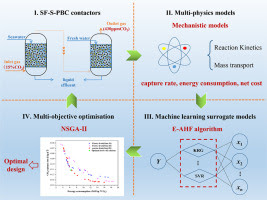Machine learning based techno-economic process optimisation for CO2 capture via enhanced weathering
ayesha iqbal
Highlights
- •
Series packed bubble column (S-PBC) contactors are designed for CO2 capture via EW.
- •
Techno-economic analysis is performed for three S-PBC configurations.
- •
Data-driven surrogate model is developed for multi-variable and multi-objective optimisation.
- •
Trade-off between maximum CO2 capture rate and minimum energy consumption is achieved.
- •
S-PBC in sequence operated with seawater and freshwater is proved to be a promising design.
Abstract
This work evaluated the practicability and economy of the enhanced weathering (EW)-based CO2 capture in series packed bubble column (S-PBC) contactors operated with different process configurations and conditions. The S-PBC contactors are designed to fully use the advantages of abundant seawater and highly efficient freshwater through a holistic M4 model, including multi-physics, machine learning, multi-variable and multi-objective optimisation. An economic analysis is then performed to investigate the cost of different S-PBC configurations. A data-driven surrogate model based on a novel machine learning algorithm, extended adaptive hybrid functions (E-AHF), is implemented and trained by the data generated by the physics-based models. GA and NSGA-II are applied to perform single- and multi-objective optimisation to achieve maximum CO2 capture rate (CR) and minimum energy consumption (EC) with the optimal values of eight design variables. The R2 for the prediction of CR and EC is higher than 0.96 and the relative errors are lower than 5%. The M4 model has proven to be an efficient way to perform multi-variable and multi-objective optimisation, that significantly reduces computational time and resources while maintaining high prediction accuracy. The trade-off of the maximum CR and minimum EC is presented by the Pareto front, with the optimal values of 0.1014 kg h−1 for CR and 6.1855 MJ kg−1CO2 for EC. The calculated net cost of the most promising S-PBC configuration is around 400 $ t−1CO2, which is about 100 $ t−1CO2 lower than the net cost of current direct air capture (DAC), but compromised by slower CO2 capture rate.
Graphic abstract

